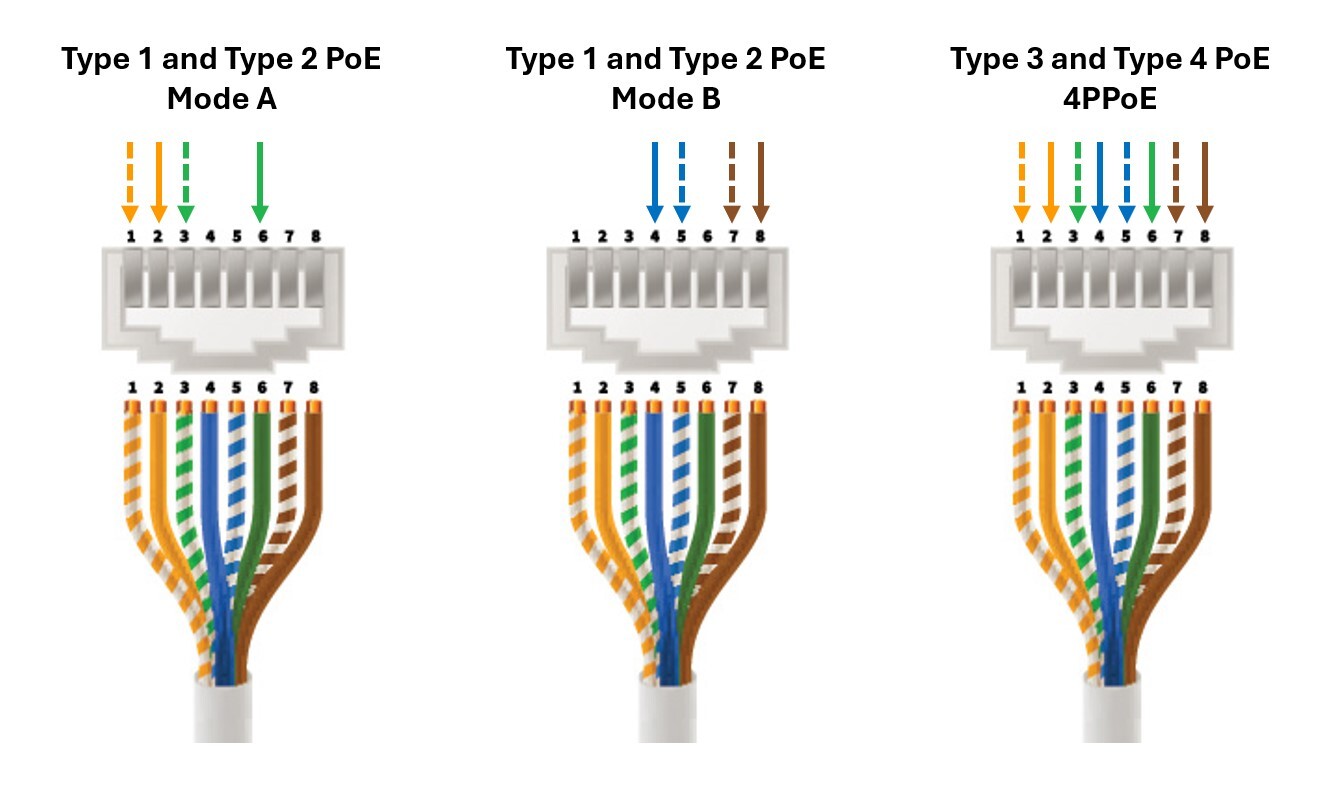Best Cables for Power over Ethernet (PoE)
- Mar 28th 2025

Since its 2003 introduction, Power over Ethernet (PoE) technology, which transmits DC power alongside Ethernet data across twisted-pair copper cabling, has experienced widespread adoption. This technology has continually progressed, exponentially increasing its power delivery to accommodate an expanding array of connected devices.
The primary advantage of PoE is substantial cost reduction by eliminating dedicated AC circuits and conduit to networked devices, which necessitate certified electrician installation. Furthermore, PoE offers enhanced efficiency and safety compared to AC power systems. Classified as a limited-energy application with a maximum power output of 100 Watts, PoE is deemed safe from fire hazards and provides adequate protection against electric shock.
A thorough understanding of the technology and the optimal type of cable is essential for those looking to reap the benefits of PoE.
How Does PoE Work?
PoE works by sending low-voltage direct current (DC) to connected network devices over twisted-pair copper LAN cables, such as Category 6 or Category 6A. To accomplish this, power sourcing equipment (PSE), such as a PoE network switch, injects DC voltage into two or four pairs of the cable. The voltage ranges from 37 to 57 VDC and is spit equally on each pair and on each conductor of a pair. Voltage flows through the device's resistor to an internal transformer that extracts the power for device operation.
Before power can be delivered to a PoE device, a "handshake" occurs between the PSE and the device. This handshake (technically called PoE negotiation) involves the PSE detecting a connected device and sending out a small amount of power to discover the presence of a resistor, which indicates a PoE device. The PSE then sends out additional voltage pulses and measures the current draw to determine the power requirements for the device. PSE can also communicate with the device using Link Layer Discovery Protocol (LLDP) to determine the specific amount of power required. This allows the PSE to deliver only the necessary amount of power for the device.
Four types of PoE are specified by IEEE application standards for delivering wattage to devices over two or four pairs of a category cable :
-
Type 1 PoE (IEEE802.3af-2003): Delivers a maximum of 15.4 W over 2 pairs, with up to 13 W available at the device
-
Type 2 PoE (EEE802.3at-2009): Delivers a maximum of 30 W of power over 2 pairs, with up to 25.5 W available at the device
-
Type 3 PoE (IEEE 802.3bt-2018): Delivers a maximum of 60 W over 4 pairs, with up to 62 W available at the device)
-
Type 4 PoE (IEEE 802.3bt-2018): Delivers a maximum of 90 W over 4 pairs, with 73.3 W available at the device.
For Type 1 and Type 2 PoE that deliver power over two pairs, PoE can be delivered simultaneously with data over pairs 1,2 and 3,6, which is referred to as Mode A. It can also be delivered over spare pairs 4,5 and 7,8, which is referred to as Mode B. Mode A is compatible with two-pair applications like 10/100BASE-T and four-pair applications like 1000BASE-T and 10GBASE-T. Mode B is only compatible with two-pair applications. Type 3 and Type 4 PoE, often called four-pair PoE (4PPoE), transmit power on all four pairs simultaneously with data in two- and four-pair data applications.

What Type of PoE Do I Need?
The type of PoE you need depends on how much power a device requires. Because devices can have a wide variety of power requirements, IEEE 802.3 PoE standards categorize the four types of PoE into Classes 1 through 8. Power requirements should be clearly specified in product documentation and may be denoted by class. PoE class may even be indicated on the device itself. When choosing PSE such as a PoE switch, the rule of thumb is to ensure that it is the same class or higher than the PoE device.

A wide range of PoE networked devices are available. PoE VoIP phones, wireless access points, surveillance cameras, access control, digital displays, and LED lights are common in most commercial buildings. While every device will have specific power requirements based on its features and capabilities, the following table shows a breakdown of approximate PoE requirements by device type.

What Type of Cable Do I Need for PoE?
Any category cable can deliver PoE, including Category 3, Category 5e, Category 6, and Category 6A. First and foremost, the primary decision factor is the required data transmission speed. Category 3 only supports a speed of 10 Mb/s (10BASE-T), Category 5e and 6 support up to 1000 Mb/s (1000BASE-T), and Category 6A supports up to 10 Gb/s (10GBASE-T). However, there are additional considerations when choosing cable for PoE that make Category 6 and Category 6A cables the best choice—even for low-speed devices.
The larger 23 AWG conductors used in Category 6 and Category 6A cables are better for PoE than the smaller 24 AWG conductors found in most Category 3 and Category 5 cables. Larger conductors have a lower resistance for more efficient PoE delivery and offer improved heat dissipation. Smaller gauge cables carrying PoE can heat up and cause increased insertion loss, preventing proper data transmission. Heat rise is especially a concern in bundles of closely packed cables carrying higher levels of PoE, which is why the NEC specifies bundling requirements for Type 3 and Type 4 PoE based on the cable gauge and temperature rating.
Another consideration is cable construction. Category 6 and Category 6A shielded (STP) cables exhibit even less temperature rise in cable bundles than unshielded (UTP) cables due to the foil or braided layer that assists with heat dissipation. In addition, because larger conductors are better for PoE, slim 28 AWG patch cords used in dense patching environments are not recommended for connecting PoE devices.
For reliable PoE performance, cables also need to be properly balanced. When PoE is injected into a Category cable, it is equally split between the conductors of a pair and between pairs. The DC resistance of conductors and pairs must be equally balanced to maintain that equal split. Too much difference in DC resistance between conductors and pairs can cause the device's transformer to become saturated, preventing PoE from functioning and causing distortion of the data signals. Category 6 and Category 6A cables tend to have better balance since they are designed with more precise and consistent conductor twists and geometry for superior crosstalk performance to support faster transmission speeds.
Outlook Good for Copper Cables
Fiber optic cabling offers superior speed and bandwidth over copper cabling, which is why it's the dominant cable type for data centers and backbone infrastructure for broadband, campus, and premises networks. However, fiber cannot support PoE. Its glass composition enables the transmission of light signals but cannot transmit electrical current.
PoE's cost and efficiency benefits ensure that Category 6 and Category 6A cables will maintain dominance in horizontal LAN infrastructure for connecting and powering a wide range of devices. In fact, the PoE solutions market is projected to surge from $2.42 billion in 2024 to over $8.45 billion by 2037.
The good news is that CablesPlus is a premier supplier of shielded and unshielded Cat 6 and Cat 6A copper cables to ensure reliable PoE performance. Contact us today for all your Cat 6 and Cat 6A copper cabling needs.
Explore Our Complete Range of Cat 6 and Cat 6A Cables Contact an Expert
